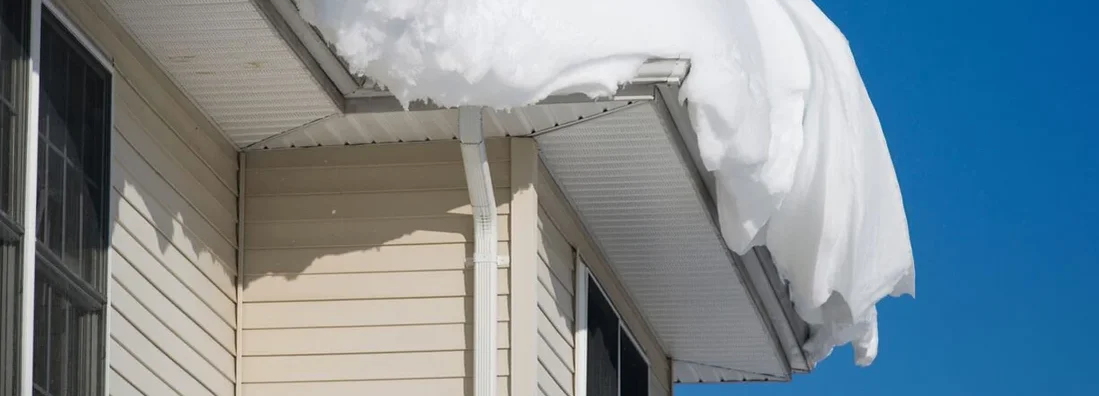Is Too Much Snow on Your Roof an Insurance Problem in Illinois?

Jeff Green has held a variety of sales and management roles at life insurance companies, Wall street firms, and distribution organizations over his 40-year career. He was previously Finra 7,24,66 registered and held life insurance licenses in multiple states. He is a graduate of Stony Brook University.

Illinois is prone to severe winters with heavy snowfall. Not only can too much snow accumulation on your roof be a hazard for serious injuries, but it can also lead to collapses and financial nightmares. Having the right homeowners insurance in place before winter hits can help you prepare.
An Illinois independent insurance agent can help you get equipped with all the home insurance you need to be protected against the complications of too much snow on your roof. They'll get you covered before that first snowstorm hits. But for starters, here's a closer look at how too much snow on your roof could be an insurance problem in Illinois.
How Much Snow Is Too Much on an Illinois Home’s Roof?
Not only does a large buildup of snow mean an eventual mess of tons of water, but the weight of the snow itself can pose serious problems before it melts.
Too much snow on your roof is dangerous because:
- The sheer weight of snow can be extreme, as lighter snow averages three pounds per square foot, while wet snow can be as heavy as 21 pounds per square foot.
- The weight of ice is even worse, as ice can weigh up to 57 pounds per square foot.
- Older homes are the most vulnerable to roof collapses because of snow and ice accumulation.
- Trapped, melting snow and ice can also lead to the formation of ice dams, which can cause serious damage to your home if the water runs off into the interior.
Removing snow and ice from your roof should be done quickly because the problem can get worse. If your roof has a low pitch, you should remove snow accumulation with a roof rake, or call in a professional ASAP.
Guidelines for Snow Removal
Luckily, snow removal doesn't always require a professional's help. With the following pointers, you can often get it done yourself.
Follow these guidelines for snow removal from your roof:
- Know your roof's limits: Learn how much your home's specific roof can support after a storm. Many roofs can hold up to 20 pounds of snow per square foot before starting to collapse.
- Determine the weight of fresh snow: You can use simple calculations to figure out how much the snow on your roof weighs. For every 10 inches of fresh snow, expect it to put about five pounds per square foot on your roof. Using this formula, you can determine that many roofs can only hold four feet of fluffy, fresh snow.
- Determine the weight of packed snow: Wet, packed snow, however, weighs considerably more than fresh, fluffy snow. Just two feet of packaged or old snow can be too heavy for your roof's limits. Also keep in mind that if your roof already had packed snow on it and now has an accumulation of fresh snow on top of that, there could be an increased chance of collapse.
- Remember to add the weight of ice: If the snowstorm presented ice along with the snow, you'll have to factor in that weight as well. Fresh snow mixed with ice and especially packed snow mixed with ice accelerates the rate of potential disaster quite a bit.
- Remove extra weight: If the snow and ice exceed your roof's threshold, you'll need to clear any amount above 20 pounds per square foot that's accumulated. While you can hire a professional, you can also invest in a snow rake and do it yourself.
- Keep an eye on your roof's status: It's necessary to keep tabs on your roof's condition, checking for signs of sprinkler lines, creaking or popping sounds, and sunken or sagging tiles, as these can all point to stress. If any of your home's doors or windows are jammed, or if you have cracks in your walls or leaks indoors, you might also have a stressed roof.
A stressed roof needs to be professionally inspected immediately. Failure to do so could lead to a collapse, which would mean not only the need for a new roof but the likelihood of damaged or destroyed property within the home as well.
How Do Ice Dams Damage Homes?
An uneven melting of snow and ice on your roof can lead to the formation of ice dams. If the precipitation in your gutters stays frozen longer than what's on your roof, the newly melted water may have nowhere to flow. That is, except for the places it's not supposed to.
This is how ice dams can damage your home:
- They can cause mold or mildew growth indoors if leaks are not noticed for a while, which can eventually lead to health issues.
- They can cause interior damage to your home if the water seeps inside through cracks and openings around windows or doors.
- They can cause basement floods if a substantial amount of water gets inside the home.
- They can lead to personal property damage, particularly in areas where the water runoff accumulates the most indoors, like a basement.
- They can cause major interior damage if water that ran off inside the home eventually refreezes and expands.
- They can destroy your gutters, which can collapse under the weight of trapped snow and ice.
Now that you're aware of just how badly ice dams can damage a home, you can be on alert for their warning signs and act quickly to prevent or remove them if necessary.
How to Protect Yourself Best from Ice Dams
Ice dams can be a nuisance, but they can also usually be prevented. Keep your home safe from ice dams by following these tips:
- Have your home inspected for temperature leaks by a professional, long before winter comes.
- Stay on top of your gutters' maintenance by always keeping them clear of debris like leaves.
- Have your home's insulation professionally inspected for flaws.
- Take the time to seal leaks in your home, particularly around doors and windows, before winter hits.
- Clear any melting snow and ice off of your roof quickly, no matter the accumulation.
- Work with an independent insurance agent in Illinois to get the right homeowners insurance.
A local independent insurance agent in Illinois can help you find the homeowners insurance coverage you need to help you recover from financial losses after an ice dam disaster.
How Does Home Insurance Help after Snow and Ice Damage?
Insurance expert Jeffery Green explained that homeowners insurance covers damage to your home caused by ice dams, but added that your policy will not cover damage to your personal property if any of the water gets inside. Homeowners insurance also covers incidents of roof collapse, which can happen after too much snow and ice accumulate.
Your home insurance also covers additional living expenses (ALE), or loss of use of your home. So, if a major snow or ice storm causes your home to need such extensive repairs that you can't live there for a while, this coverage would pay for unexpected fees. ALE coverage can reimburse you for hotel stays, takeout meals, extra gas mileage, dry cleaning, and more while your home is repaired.
When Is Ice Damage Not Covered?
Ice that thaws and leads to water runoff indoors is not typically covered by home insurance. Damage to outdoor property caused by the weight of ice is also not usually covered. Further, frozen indoor plumbing that occurs because the homeowner went on vacation and turned their heat off is also excluded.
Talk with your Illinois independent insurance agent more about how your home insurance covers ice, snow, and ice dam damage to your home, and when it doesn't. Also, keep the above checklists in mind for signs of too much snow accumulation on your roof and how to remove it and prevent ice dams. Winters don't have to be a nightmare when you're adequately prepared.
Why Choose an Illinois Independent Insurance Agent?
Illinois independent insurance agents simplify the process by shopping and comparing insurance quotes for you. Not only that, but they’ll also cut through the jargon and clarify the fine print so you'll know exactly what you’re getting.
Illinois independent insurance agents also have access to multiple insurance companies, ultimately finding you the best home insurance coverage, accessibility, and competitive pricing while working for you.
https://www.usatoday.com/story/news/nation/2015/02/21/kostigen-snow-roof/23671405/
https://www.chicagotribune.com/business/ct-biz-winter-weather-ice-dam-insurance-20210225-hhk4cvb47jaa5ohkmrf7pa27yi-story.html
https://icedamremovalguys.com/ice-dam-facts/
